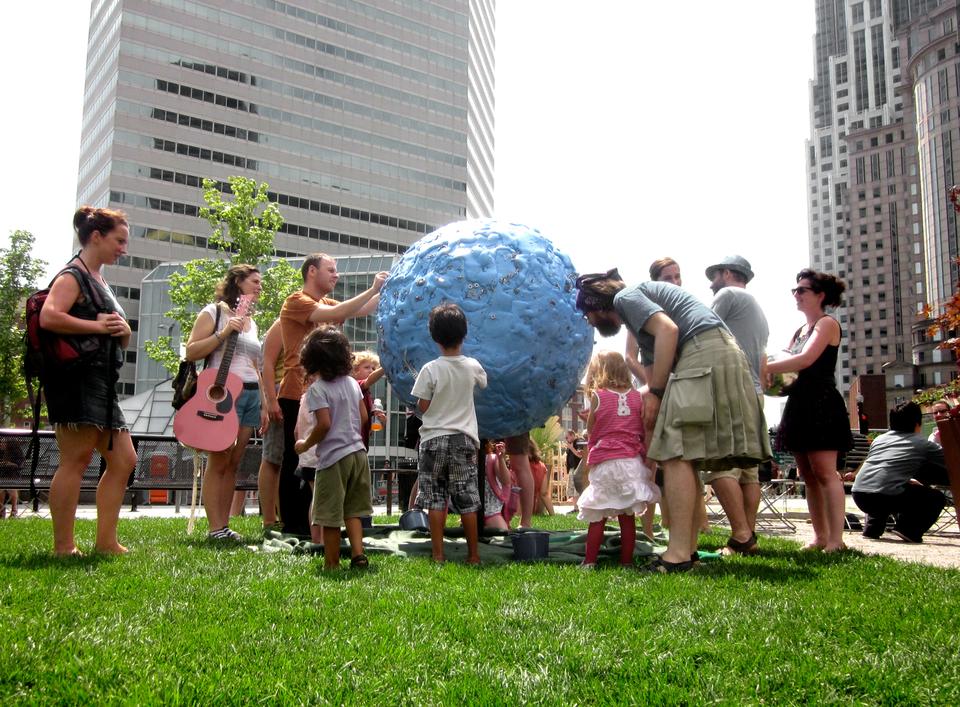
News
Progressive Labor Party Organizes Solidarity March With Harvard Yard Encampment

News
Encampment Protesters Briefly Raise 3 Palestinian Flags Over Harvard Yard

News
Mayor Wu Cancels Harvard Event After Affinity Groups Withdraw Over Emerson Encampment Police Response

News
Harvard Yard To Remain Indefinitely Closed Amid Encampment

News
HUPD Chief Says Harvard Yard Encampment is Peaceful, Defends Students’ Right to Protest
Artful Activists’ Public Appeals

Last winter, a 20-foot-tall wooden structure designed by architect Keith Moskow sat on the Rose Kennedy Greenway in Boston, waiting for snow. It was meant to collect the snow and freeze it into icicles, which would form around large, swaying metal chimes and then crack and fall, but the piece never got the chance to perform—it was one of the warmest winters on record in Boston history.
Moskow described the unanticipated failure Thursday in a discussion entitled “What is Today’s Public Art? A Chorus of Ideas,” which was cosponsored by Harvard’s Arts @ 29 Garden and the New England Foundation for the Arts. Moskow and 11 other regional artists whose media range from bronze to baseball caps gave brief presentations on their recent work and debated issues of activism and accessibility in public art.
Like Moskow, several of the participants identified themselves as more than artists. Lori A. Lobenstine, the co-founder of the Design Studio for Social Intervention in Roxbury, said she considers herself an activist. She described her work with urban youth to design Let’s Flip It, a campaign against violence centered around the symbol of a white baseball cap. “We started to feel like activism was getting stuck in some familiar forms,” Lobenstine said. “Artists have helped us think about the symbolic and particularly how symbols are used by communities, cultures, and people to make collective meaning.”
Activism also figures prominently in the work of China Blue, who aims to raise awareness through light sculptures of light pollution—particularly, she said, because it diminishes the noticeability and wonder of fireflies’ lights. And Sara A. Hendren, a Graduate School of Design student, is working to improve wheelchair accessibility through ramp design and construction and through a website devoted to the concept of slope. Hendren, who calls herself a “public amateur,” said after the discussion that she values the opportunity public art provides to advance her cause subtly and creatively. “I started to think about what the public art project would look like that would raise this issue [of wheelchair accessibility] but not be finger wagging and a purely policy-change effort,” Hendren said.
As in Blue’s piece, the idea of mimicry of nature arose in other artists’ works, like those of Ben M. Houge. Houge described his new piece at the Boston Harbor Islands Pavilion—a large, pixelated screen that lights up in accordance with various data inputs. Some pixels reflect the light patterns of the Boston Harbor Islands lighthouses, while others reflect tides, waves, winds, and bee populations on the Harbor Islands.
Elizabeth Billings and Andrea Wasserman have also worked together to produce installations reminiscent of nature. They presented a recent piece, installed at the City University of New York School of Law, that features stripped saplings. The piece is intended to give the feeling of deep woods in an urban environment, according to Wasserman. She and Billings also have work in hospitals and airports. “I think our work often helps people just take a deep breath,” Billings said after the talk.
Houge and others also noted a persistent challenge that faces public artists—to make their work accessible and not overly enigmatic, but nonetheless thought-provoking. Houge, who has worked composing music for mass-market video games, drew a parallel between the need to build audience of a public artist and of an orchestra attempting to gain repute. “It’s not [about] giving people what they want to hear; it’s about creating a dialogue not only over the course of a concert program but over a season and over a couple of seasons and challenging people,” he said. “Even if they disagree, they’re drawn into the conversations.”
In an interview after the discussion, Houge asserted that art must in some way benefit society—an opposition to the view presented by another artist, Dan Sternof Beyer, that art is simply that which is considered as such by its audience. “I feel like to say that ignores the responsibility of art to ennoble,” Houge said. “I think there’s a responsibility that you’re doing something that is somehow making things better, somehow even making people better.”
But, Lobenstine said after the discussion, neither should artists neglect the artistic in art that aspires to social improvement. “If we want it to be an effective social intervention, it has to be beautiful or elegant or creative in a way that captures people’s attention. It can’t be like, ‘That was kind of lame, but I get their point’ [or] ‘That was kind of lame but it’s a good message,’” she said. “No, that’s not going to do the trick.”
—Staff writer Rebecca J. Mazur can be reached at rmazur@college.harvard.edu.
Want to keep up with breaking news? Subscribe to our email newsletter.
